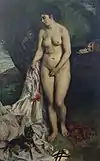Alfred Cassirer (29 July 1875 – 11 July 1932) was a German engineer, entrepreneur and art collector.
Life
Born in Görlitz,[1] Cassirer came from the entrepreneurial Cassirer family and was the youngest son of Louis Cassirer and a brother of Paul, Hugo and Richard Cassirer. Together with his brother Hugo Cassirer and his uncle Julius Cassirer owner of the company Kabelwerk Dr. Cassirer und Co. in Berlin-Hakenfelde. Cassirer was also the second representative of Section I of the "Maschinenbau- und Kleineisenindustrie-Berufsgenossenschaft".[2]
He was also an active hot air ballooner, co-founder of the Kaiserlicher Aero-Club at the Johannisthal Air Field near Berlin and won 1st prize in Class 3 in the 1908 International Race with his balloon "Hewald" in the endurance flight.[3] He was also a co-partner of the Motorluftschiff-Studiengesellschaft.[4]=[5]
On 15 July 1912, Alfred Cassirer married Hannah Sotschek (1887-1974), who, after divorcing around 1923, married Leo Blumenreich in a second marriage. The marriage produced the philosopher Eva Cassirer (1920-2009).[6]
Cassirer died two and a half weeks before his 57th birthday on 11 July 1932 in Berlin. His grave is located in the state-owned Friedhof Heerstraße in Berlin-Westend.[7] The grave monument consists of an unadorned plinth, consisting of three dimension stones from shell limestone, on which stands a relief showing six grazing sheep. This frieze was created by the firm Schleicher & Co. after a drawing by August Gaul entitled "Sheep in the Campagna".[8]
Cassirer was a art collector and decreed testamentarially that his entire collection was to be given to the Magistrat von Berlin to be given to the Märkisches Museum as a permanent loan. From March 1933, it was presented in five rooms on the first floor of the Ermelerhaus, a branch of the Märkisches Museum, Breite Straße 11 in Mitte. The works on display included drawings by Adolph von Menzel, works by Max Liebermann and Max Slevogt, sculptures by Ernst Barlach, Georg Kolbe and August Gaul. Among the main works in the collection were paintings by French artists such as Gustave Courbet, Édouard Manet, Claude Monet, Edgar Degas, Pierre-Auguste Renoir, Camille Pissarro, Alfred Sisley and Paul Cézanne.
 Édouard Manet: Femme au Chapeau à Brides, 1881, today Baltimore Museum of Art
Édouard Manet: Femme au Chapeau à Brides, 1881, today Baltimore Museum of Art Pierre-Auguste Renoir: Badende, 1870, today Museu de Arte de São Paulo
Pierre-Auguste Renoir: Badende, 1870, today Museu de Arte de São Paulo
References
- ↑ S. Bauschinger gives 14 September 1882 in Breslau as his birthday and place of birth
- ↑ Cassirer, Alfred. In Georg Wenzel: Deutscher Wirtschaftsführer Hanseatische Verlagsanstalt, Hamburg / Berlin / Leipzig 1929, DNB-IDN 948663294, p. 39.
- ↑ Cassirer, Alfred. In Gustav Braunbeck (ed.): Braunbeck's Sport-Lexikon. Braunbeck-Gutenberg, Berlin 1911, p. 239. (Braunbeck, Gustav (1911). "Cassirer, Alfred".)
- ↑ Gesellschafter.' In Jahrbuch der Motorluftschiff-Studiengesellschaft, vol. 3 (1908), p. 15.
- ↑ Shareholder. In Jahrbuch der Motorluftschiff-Studiengesellschaft, vol. 4 (1910-1911), p. 21.
- ↑ see bibliography S. Bauschinger.
- ↑ Bezirksamt Charlottenburg-Wilmersdorf von Berlin: Prominentengrabstätten auf dem landeseigenen Friedhof Heerstraße. Notice posted at the cemetery. As of: November 2012. Read on 3 December 2019.
- ↑ Gravesite Alfred Cassirer. In Jörg Haspel, Klaus von Krosigk (ed.): Garden Monuments in Berlin. Imhof, Petersberg 2008, ISBN 978-3-86568-293-2. p. 35.
Further reading
- Sigrid Bauschinger: Die Cassirers. Unternehmer, Kunsthändler, Philosophen. C. H. Beck, Munich 2015, ISBN 978-3-406-67715-1, pp. 19 f., 51, 55, 57, 96, 118, 125, 128f., 142, 145, 178, 220, 225, 229, 333, 345, 357, 393.
- Eine Impressionisten-Galerie im Ermeler-Haus. In Vossische Zeitung, 11 March 1933